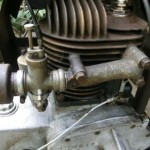Forum Replies Created
-
AuthorPosts
-
December 20, 2013 at 11:42 am #4247
 wristpinParticipant
wristpinParticipantThat’s the one, second cousin to the Bex Bissel!
December 17, 2013 at 9:29 pm #4199 wristpinParticipant
wristpinParticipantA rough test is, with the engine running, to try and move the governor arm in the direction that will open the throttle plate (butterfly) and as the engine speeds up you should feel the governor trying to oppose you. Amongst others Both Villiers and JAP achieved governor control use using “ungoverned” carburettors by inserting a throttle butterfly into the inlet manifold -I guess that this is what you have.
December 17, 2013 at 7:59 pm #4192 wristpinParticipant
wristpinParticipantWith the engine running the internal centrifugal fly weights will try to close the throttle plate. This closing force is opposed by the tension of the throttle cable acting through the governor spring. When the two forces are in equilibrium you have the governed speed.
So with slack in the cable the throttle plate should be closed,held slightly open by the idle stop screw. If the throttle plate is fully open with the engine running It is possible that the governor arm is incorrectly positioned in relation to the shaft connected to the internal mechanism. The throttle plate being open when the engine is not running does not necessarily denote a problem.
The inability to achieve acceptable idle rpm in an oldish engine is often down to throttle spindle wear etc rather than a governor problem.December 17, 2013 at 5:03 pm #4182 wristpinParticipantDecember 17, 2013 at 3:50 pm #4181
wristpinParticipantDecember 17, 2013 at 3:50 pm #4181 wristpinParticipant
wristpinParticipantEngine-Been run loose or dropped and then someone’s been practicing their alloy welding skills!
Carb bowl – Araldite or JB Weld or some such.December 16, 2013 at 11:50 pm #4172 wristpinParticipant
wristpinParticipantHave sent you a pm. This may apply to your machine but the parts list is not dated.
Attachments:
December 16, 2013 at 7:54 pm #4167 wristpinParticipant
wristpinParticipantAs has already been suggested, rolling pins from fleabay can be a good source for front rollers. Got some nice beech ones that matched Ransomes Marquis to within a mm or two but couldn’t get a good match when a needed some for an Atco. However then discovered Bob only 6 miles away who made a set of 4 rollers, 2 handle bar grips and crank handle grip for £40 all in which I thought pretty reasonable.
December 16, 2013 at 7:04 pm #4164 wristpinParticipant
wristpinParticipantA few years ago I had new windows fitted by a very well known national company. Part of the job involved 11 units in a semi circular “conservatory” and because the units support a tiled roof their structural engineer specified “stainless steel props” between each unit. A couple of years after installation two of the plastic trims came adrift to reveal bits of 4X2 timber!
When challenged, their reply was that they were adequate for the job and they didn’t see/want to see that they were not what was quoted for and paid for. I had a lot on my plate at work at the time and didn’t take it any further but I know I should have.
Sending out badly presented and ill equipped “tradesmen” who demonstrate poor technical proficiency and even less respect for one’s car/property etc seems to be becoming the norm these days.
Bah humbug !!!!!!!!December 16, 2013 at 6:34 pm #4157 wristpinParticipant
wristpinParticipantTheres an ATCO kickstart, a Qualcast with a box and knackered front rollers and a Hayterette.
That Qualcast Commodore was, in my opinion, a much underrated machine. With its “proper” clutch was so much easier to use than the equivalent Suffolks with centrifugal clutches. Probably why the grassbox has survived in apparent good order! Hope that it goes to a good home.
December 14, 2013 at 5:51 pm #4041 wristpinParticipant
wristpinParticipantI had – you sent it to me!
The Villiers/Sunbeam/Seagull relationship just goes to show how things evolved but are now just taken at face value.December 13, 2013 at 8:24 pm #4025 wristpinParticipant
wristpinParticipantJust to expand a bit on the importance of a correctioally functioning crankcase breather. It is not only there to allow air to exit the crankcase when displaced by the descending piston but also to close and maintain a slight negative pressure when the piston ascends.
Venting the crankcase prevents oil being forced out around valve stems and crankshaft seals and the partial vacuum further assists with keeping the oil inside the engine.
All this is a long winded way of saying that the sealing is every bit as important as the venting.
On your Suffolk engine the breather lurks inside the valve chest. Undo the nut securing the cover just below the inlet and exhaust manifolds and the breather is in the middle secured by a compressed sping hooked asound the cover securing stud. Inside the little alloy breather body is a small paxolin disc or poppet valve. If this is working properly it should allow crankcase air out but not in. The alloy bodies wear as do the discs and as neither is still available you are probably stuck with what you have but some improvement may be achieved by turning the disc over to present an unworn face to the valve body. If you are really keen the face of the body can be skimmed to square it up and present a better sealing face to the disc – the smallest cutter from a bath/basedin reseating cutter kit can be reduced in diameter to do this. Also using a straight SAE30 oil may help.December 12, 2013 at 6:28 pm #3985 wristpinParticipant
wristpinParticipantMorris’s Carb Cleaner does.
December 12, 2013 at 2:35 pm #3979 wristpinParticipant
wristpinParticipantPerhaps you need a “bigger drop” of fuel to get her several firing strokes. Try lacing the air filter element with a good dollop of fuel – in the open air and have an extinguisher handy just in case. If you then get a few firing strokes in succession you have proved the point that it’s a fuel supply issue. I’ve got a handy squeeze bottle with brass spout (Partco or Sparex from the local ag merchant) that’s just the job for such occasions.
December 11, 2013 at 7:08 pm #3954 wristpinParticipant
wristpinParticipantIt will have hardened valve seat inserts so no problem there,but if you want a bit of extra protection for the valve stems and guides a drop of two-stroke oil or good old Redex will do the trick. All my old BSAs and Villiers get that treatment.
E5 won’t be a problem so long as it’s fresh and not left in the system to evaporate and deposit gum. If you are concerned about “shelf life” you can use a stabilising additive such as B&S’s Fuel Fit or Fuel Fresh (same product, different packaging) but I don’t bother and as yet have not suffered any problems. For long tern storage the advantage of a stabilising additive over “running dry” is that the tiny bit of fuel left in the dark recesses of the carb ready to cause trouble will be protected.December 10, 2013 at 9:48 pm #3934 wristpinParticipant
wristpinParticipantWhen I said “the same” I was referring to valve clearances and points gap. Bores are different but as far as I can remember the crank throws are the same. Sumps on both depend on the application and are interchangeable to raise or lower the crank centre line to suit the machine.
Your pic of the Suffolk engined machine is a bit small to see the detail but I suppose that it is an Atco chassisand not one of the Suffolk variants which were totally different mechanically. The most obvious difference, as far as I recall, was that the Atco had a multi-plate manually operated clutch where as the Suffolks had a centrifugal one. -
AuthorPosts

